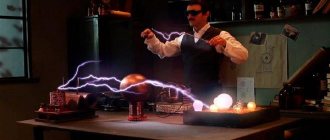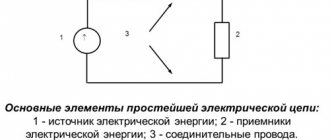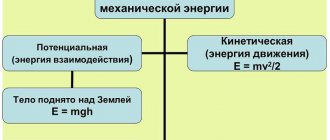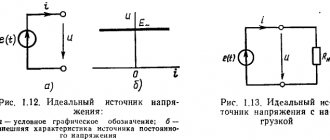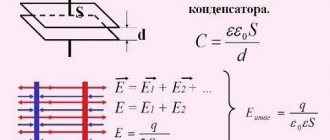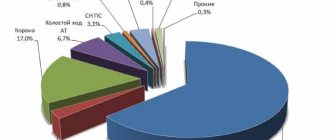Who is the main culprit in electricity consumption?
The range of appliances in our homes is naturally different, as are the models, the class of electricity consumption and the power of household appliances. All these factors certainly affect the amount of energy used, and accordingly the costs for this item. To accurately determine the main consumer, you can create the following table:
In our case, the total consumption is 180 kW/h per month. Of course, such a calculation will not be particularly accurate, because operating time, quantity and type of equipment used can vary greatly over time. Think of a table like this as more of a starting point to help you map out ways to save energy in your home.
TV
This electrical appliance is found in almost every home, and some even have a TV in every room. And, of course, most people never unplug the TV, not even realizing that it consumes electricity even in sleep mode - about 25 watts per day or 750 watts per month. Accordingly, two TVs “steal” twice as much electricity from you, and three TVs “steal” you three times. This is why you should unplug all televisions in your home, at least while you're away and sleeping.
Methods for determining the electricity consumption of household appliances and tools
The average electricity consumption in citizens' apartments per month is the sum of the total electricity consumption of all electrical appliances used by its residents. Knowing the electricity consumption for each of them will give an understanding of how rationally they are used. Changing the operating mode can provide significant energy savings.
The total amount of electricity consumed per month in an apartment or house is recorded by the meter. There are several ways to obtain data for individual devices.
A practical way to calculate electricity consumption based on the power of an electrical appliance
The average daily electricity consumption of any home appliance is calculated using the formula; just remember the basic characteristics of electrical appliances. These are three parameters - current, power and voltage. Current is expressed in amperes (A), power in watts (W) or kilowatts (kW), and voltage in volts (V). From the school physics course, we remember how electricity is measured - it is a kilowatt-hour, it means the amount of electricity consumed per hour.
All home appliances are equipped with labels on the cable or on the device itself, which indicate the input voltage and current consumption (for example, 220 V 1 A). The same data must be present in the product passport. Based on current and voltage, the power consumption of the device is calculated - P=U×I, where
- P – power (W)
- U – voltage (V)
- I – current (A).
We substitute the numerical values and get 220 V × 1 A = 220 W.
Next, knowing the power of the device, we calculate its energy consumption per unit of time. For example, a regular liter electric kettle has a power of 1600 W. On average, he works 30 minutes a day, that is, ½ hour. We multiply the power by the operating time and get:
1600 W × 1/2 hour = 800 W/h, or 0.8 kW/h.
To calculate costs in monetary terms, we multiply the resulting figure by the tariff, for example, 4 rubles per kWh:
0.8 kW/h×4 rub.=3.2 rub. Calculation of the average monthly fee - 3.2 rubles * 30 days = 90.6 rubles.
In this way, calculations are made for each electrical appliance in the house.
Counting electricity consumption using a wattmeter
The calculations will give you an approximate result. It is much more reliable to use a household wattmeter, or energy meter - a device that measures the exact amount of energy consumed by any household device.
Digital wattmeter
Its functions:
- measuring power consumption at a given moment and over a certain period of time;
- current and voltage measurement;
- calculation of the cost of consumed electricity according to the tariffs you have set.
The wattmeter is plugged into a socket and the device you are going to test is connected to it. The display shows power consumption parameters.
Current clamps allow you to measure the current and determine the power consumed by a household appliance without disconnecting it from the network. Any device (regardless of manufacturer and modification) consists of a magnetic circuit with a movable disconnect bracket, a display, a voltage range switch and a button for recording readings.
Measurement procedure:
- Set the desired measuring range.
- Open the magnetic circuit by pressing the bracket, place it behind the wire of the device under test and close it. The magnetic core must be located perpendicular to the power wire.
- Take readings from the screen.
If a multi-core cable is placed in the magnetic core, the display will show zero. This happens because the magnetic fields of two conductors carrying the same current cancel each other out. To obtain the required values, measurements are carried out on only one wire. It is convenient to measure energy consumption through an extension cord-adapter, where the cable is divided into separate cores.
Determining energy consumption using an electric meter
A meter is another simple way to determine the power of a household appliance.
How to count light using a meter:
- Turn off everything in the apartment that runs on electricity.
- Record your readings.
- Plug in the desired device for 1 hour.
- Disable it and subtract the previous readings from the received numbers.
The resulting number will be an indicator of the electricity consumption of the individual device.
Electricity consumers in the house
Decree of the Government of the Russian Federation No. 334 “On improving the procedure for technical connection of consumers to electrical networks” dated April 21, 2009 states that a private individual can connect up to 15 kW to his home. Based on this figure, we will make a calculation to determine how many kilowatts will be enough for our home. To carry out the calculation, you need to know how much electricity each electrical appliance in the house consumes.
Power table of household electrical appliances
The power table for household electrical appliances shows approximate electricity consumption figures. Energy consumption depends on the power of the devices and the frequency of their use.
| Electrical appliance | Power consumption, W |
| Appliances | |
| Electric kettle | 900-2200 |
| Coffee machine | 1000-1200 |
| Toaster | 700-1500 |
| Dishwasher | 1800–2750 |
| Electric stove | 1900–4500 |
| Microwave | 800–1200 |
| Electric meat grinder | 700–1500 |
| Fridge | 300–800 |
| Radio | 20–50 |
| TV | 70–350 |
| Music Center | 200–500 |
| Computer | 300–600 |
| Oven | 1100–2500 |
| Electric lamp | 10–150 |
| Iron | 700–1700 |
| Air purifier | 50–300 |
| Heaters | 1000–2500 |
| Vacuum cleaner | 500–2100 |
| Boiler | 1100–2000 |
| Instantaneous water heater | 4000–6500 |
| Hairdryer | 500–2100 |
| Washing machine | 1800–2700 |
| Air conditioner | 1400–3100 |
| Fan | 20–200 |
| Power tools | |
| Drill | 500–1800 |
| Hammer | 700–2200 |
| Circular saw | 700–1900 |
| Electric planer | 500– 900 |
| Electric jigsaw | 350– 750 |
| Grinding machine | 900–2200 |
| A circular saw | 850–1600 |
Let's do a little calculation based on the data from the table of power consumption of household electrical appliances. For example, in our house there will be a minimum set of electrical appliances: lighting (150 W), refrigerator (500 W), microwave (1000 W), washing machine (2000 W), TV (200 W), computer (500 W), iron (1200 W), vacuum cleaner (1200 W), dishwasher (2000 W). In total, these devices will consume 8750 W, and given the fact that these devices will almost never be turned on at once, the resulting power can be divided in half.
Calculation of main electricity consumers
Every home uses a variety of household appliances - from electronic watches to dishwashers. They all consume electricity, and you need to be able to calculate the values for power from a single-phase or three-phase network. The total amount will depend on the standard and tariff established in the country.
Washing machine
This device belongs to powerful household appliances. Average power is 2000 W. At one time the machine works for about one and a half hours. Accordingly, 2000 × 1.5 = 3000 W of energy or 3 kW will be consumed per wash. This number is multiplied by the number of washes. For example, a person does 10 washes in a month - the machine will use 3*10=30 kW of electricity. When multiplied by the tariff, the cost that the owner must pay to the service provider is obtained.
Energy consumption will also be calculated depending on the weight of the laundry and the selected mode. The operating time of the device also depends on these indicators. A significant part of the energy is spent on heating water.
TV
As with a computer monitor, the power consumption of a TV depends on the size of the screen. The design of the device also has an impact. Old TVs powered by a cathode ray tube require 60-100 W, LCD models about 150-250 W, plasma models - 300-400 W.
Standby mode also requires energy. This is because there will be a red light on the screen, which also requires power. For devices based on a cathode ray tube, 2-3 W are required, for modern TVs 4-6 W.
Fridge
This is a device that works without interruption 24 hours a day, seven days a week. But depending on the time of year, the amount of electricity needed will vary. In winter, operation requires approximately 2 times less electricity than in summer.
Refrigerators are divided into classes based on energy consumption. Products with low energy consumption consume energy approximately equal to the volume of the device in liters. A device with a volume of 250 liters requires an average of 250 kW per year. The exact value can be found in the documentation for the refrigerator.
Kettle, iron, stove
An electric kettle requires on average 1.5-2.5 kWh of energy. The water heats up in about 4 minutes, i.e. this energy will be spent in 15 times. An iron consumes approximately the same power, but it depends on the operating mode. Maximum load required for initial heating. An electric stove is a powerful device; it requires approximately 3 kWh of energy to operate.
Microwave
The amount of electricity consumed depends on the volume, equipment, and operating modes. For quick heating, 0.9 kWh is required, for defrosting 0.2-0.4 kWh. The volume of food also affects power - a larger portion will require a greater load.
Warm floor
Electricity consumption for heated floors depends on the type and quality of thermal insulation, operating mode, room size, climatic conditions, type of coating and other important criteria. If the floor is the only and main source of heating, then about 0.2 kWh of energy will be spent per 1 square meter. To maintain a comfortable temperature in the room, 0.1-0.16 kWh of electricity will be consumed per 1 sq.m. To calculate the monthly costs for heated floors, you should multiply the consumption by 1 sq.m. on the area of the room, operating hours and number of days per month. For a more accurate determination, you can use a wattmeter. It is connected to an outlet and to an electrical receiver.
Refrigerator: 160–550 kWh per year
How much does he spend?
Unlike other equipment, the refrigerator works 24/7 - and this cannot be changed. Therefore, when choosing, it is important to look at two indicators: energy consumption class and annual kWh consumption - these parameters are in the technical specifications.
| Energy class | Average energy consumption per year, kWh | Average cost of energy consumption, rub. |
| A+++ | 160 | 779 |
| A++ | 240 | 1168 |
| A+ | 300 | 1461 |
| A | 350 | 1704 |
| B | 450 | 2191 |
| WITH | 550 | 2678 |
True, there are also situations when even class does not play a decisive role. For example, an A++ refrigerator can burn as much as a class A model - this depends on the volume, number of refrigerators and additional functions.
How to save money
Perhaps the only way to reduce expenses on a refrigerator is to extend its service life. There are some simple tips for this:
- do not install the refrigerator next to the stove
- do not put hot food inside
- defrost in a timely manner - if there is no No Frost function.
The mathematics is simple: if your class A device breaks down and costs 2,000 rubles per year, you can replace it with class A++, which will cost 1,000 rubles per year. But at the same time, you will have to pay at least 30,000 rubles for the purchase itself - and it will only be “repaid” after 30 years.
Main household consumers
Each apartment has its own range of appliances and equipment. The same types of equipment may have different technical characteristics, power and energy consumption. As a result, all these factors have a significant impact on the amount of electricity consumed. Accordingly, the electricity payment for each family will be different.
In order to plan possible expenses, many owners draw up a special table indicating the main consumers, their power and duration of operation during the day.
The table clearly shows that the devices that consume most of the electricity are the refrigerator, washing machine, iron, electric kettle, computer, TV and lighting system. With these devices, the monthly total electricity consumption is, on average, 120-180 kW. These numbers may vary depending on the time of year when unscheduled equipment is used.
Unforeseen costs include small household appliances - hair dryer, coffee maker, chargers and others that provide the required level of comfort. In addition, in private country houses you can often find water pumping stations, circulation pumps in the heating system, electrical equipment for convectors, gas boilers and water heaters. Many people use electric heating boilers, electric stoves, ovens and welding equipment.
Air conditioners in hot summer months consume from 60 to 120 kW per month. Electric oil heaters turn up about the same amount in winter.
Is it possible to calculate electricity consumption knowing the approximate power
When making your own calculations, do not forget about the small power that some devices consume even when they are not working, but are connected to an outlet. It also needs to be counted. Many appliances are equipped with an indicator, or they have an LED, which can also consume some power.
Calculations are made as follows:
When calculating power according to the formula, you get an approximate value. In the case when you need an accurate indicator of power, it is better to use a wattmeter. Any power, be it electrical, thermal or mechanical, is measured in watts
In order to be able to save energy, it is important to know their power consumption by devices. To calculate the difference between two powers, subtract one such value from the other.
When you pay your electricity bill, you are essentially paying for every kilowatt you use. To convert watts to kilowatts, you need to divide one watt reading by 1000, and then multiply the resulting kilowatt value by the number of hours worked by the device. As a result, you will get the required value, existing as (kWh). If you multiply it by the cost of 1 kilowatt of electricity, you can find out how much you will have to pay to operate the device. For example, if there are only 10 light bulbs in your house or apartment and 100 W is the power consumed by each lamp, then after calculating we will get 10 x 100, resulting in 1000 W - the total power of all lamps. If you divide 1000 W by 1000, you get 1 kW. Now it is not difficult to calculate that if the light bulbs burned for 2000 hours a year, and one kilowatt per hour costs 6 rubles. Then, for a year you will have to pay 12,000 rubles.
Electric stove: 730–1095 kWh per year
How much does it consume
? The equipment that feeds you consumes the most electricity - a conventional electric stove. Even if you turn it on for only 1 hour a day and use 2 burners instead of four, you will earn as much as 3,500 rubles in a year. And this is in the most economical energy consumption class - with others, the costs will be even higher.
| Energy class | Average energy consumption of a burner for 1 hour, kWh | Average energy consumption for 365 hours per year, kWh | Average cost of energy consumption per year, rub. |
| A | 1 | 730 | 3555 |
| IN | 1,2 | 876 | 4266 |
| C | 1,5 | 1095 | 5332 |
How to save money
Significant savings are difficult to achieve, but there are a couple of life hacks:
- Choose the right size utensils.
If you place a large pan on a small burner, it will heat up faster, since all the heat will go only to it. But you shouldn’t put small pans on large burners - most of the heat will go into the air. - Use the residual heat from the burner
to reheat food. Then you won’t have to spend watts on the microwave either.
Dmitry Gromyko electrician
4,99 437
Open profile
A good option is to switch to an induction cooker. It does not heat itself, but only the dishes. Accordingly, less time is spent on cooking, and the efficiency of the stove itself is higher. For example, on an induction stove, 2 liters of water boil in 5 minutes, and on an electric stove - in 20 minutes.
Energy consumption
Calculating energy consumption for a house or apartment is not particularly difficult. To do this, you need to perform the following algorithm of actions:
- make a table of all electrical appliances used in the house, including lighting lamps;
- put in separate columns: device power, operating hours per day;
- for each energy consumer, calculate (by multiplying the power by the operating time) the average daily consumption;
- sum up all the obtained power values.
Such a calculation will give a real picture of electricity consumption. Using this data, you can control consumption and adjust the daily power consumption of each device.
It does not matter how power consumption is calculated or measured. The main task of the process is to correctly select the cross-section of conductors for wiring, supplying power cables and ensure that automatic protection is triggered
The cable supplying voltage to the room must withstand the simultaneous switching on of all consumers located in it for a long time. Its choice directly depends on the accuracy of determining the power of consumers.
How much electricity can household electrical appliances consume?
1. Computer
Calculations that will show how much electricity a computer consumes will be carried out approximately, since everything depends on the power of your computer’s power supply and the specific work that the computer is performing at the moment.
For example, if the power of a computer unit is from 350 to 550 Watts, it is unlikely to consume all the power even under full load. It is also necessary to take into account the monitor - from 60 to 100 watts. In total, with an average computer power supply of 450 Watts and a monitor of 100 Watts, you get 550 Watts or 0.55 kW of electricity per hour. This figure is greatly overestimated. For an approximate calculation, you can take the maximum value - 0.5 kW/h. Thus, when using a computer 4 hours a day, the result is 60 kW/h per month. (0.5*4*30). Now you can build on these numbers, for example, when using a computer 8 hours a day, we get 120 kW/h. per month.
2. Refrigerator
The technical data sheet for the refrigerator indicates the annual electricity consumption. Basically, this figure ranges from 230 to 450 kW/h. Dividing this value by 12, we get from 20 to 38 kW/h of electricity consumption per month. This indicator is applicable only for ideal conditions. The amount of power consumed depends on the volume of the refrigerator and the number of products in it. It is also necessary to take into account external conditions depending on the time of year.
3. TV
TVs are different. On average, for calculation, we will take 100 Wh. For example, when watching TV you spend 5 hours a day - 0.5 kWh. Per month - about 15 kW/h. LCD TVs with large screen diagonals consume 200-50 W per hour. Screen brightness also plays an important role. Accordingly, we calmly multiply the number of kilowatt-hours spent per month by 1.5. It turns out to be about 23 kW/h, but this is an average value, do not forget about it. Large plasma TVs consume between 300 and 500 watts per hour. If you have several different TVs in your apartment, add up the values.
4. Washing machine
To determine how much electricity a washing machine consumes, you need to know the washing mode, the weight of the laundry and the type of material. On average, the power will range from 2 to 2.5 kW/h. However, it is rare for machines to consume this amount of electricity. For calculations, you can take from 1 to 1.5 kW/h. When washing 2 times a week for 2 hours, we get from 16 to 24 kW/h.
5. Kettle and iron
The biggest energy consumers in an apartment are the kettle and iron. Operating for a minimum amount of time, they consume the same amount of electricity as some appliances per month. With a kettle power of 1.5 to 2.5 kW/h, using it 4 times a day for 5 minutes, we get from 20 to 25 kW/h per month. It's a similar story with the iron. Its power is approximately the same as that of a kettle; if you iron it 3 times a week for 1 hour, you get from 25 to 30 kW/h per month.
Not all appliances that consume electricity are listed here; they also include microwave ovens, vacuum cleaners, phone chargers and laptops. You also need to take into account incandescent lamps, which, depending on their number, power and operating time, can consume from 50 to 100 kW/h of electricity per month.
As a result, through such calculations, we obtain an approximate electricity consumption that will range from 200 to 300 kW/h per month.
Many people have heard that increased electricity bills are entirely your fault. Either you sit at the computer a lot, or you watch TV for too long, and you also iron and wash too often. But let's try to figure out how much electricity household electrical appliances can consume.
Washing machine
Another exhibit that claims to be a leader in the ranking of the most “gluttonous” electrical appliances is a washing machine. Machines with a timer are especially expensive for their owners - after all, even in a sleeping state, such a device can spend about 30 watts per day. And to save a little, don’t wash things every day - wait until you have accumulated at least 2.5–3 kg of laundry. But you shouldn’t overload the drum either - this will also have a negative effect on the meter readings.
How and why to save energy based on data on electricity consumption of household appliances
There are at least two reasons why you need to save energy. This is saving natural resources and reducing harmful emissions into the atmosphere and reducing consumer expenses. Analyze how much electricity each appliance in your home uses and whether this figure can be reduced. If the total consumption exceeds the average statistical norm of electricity consumption in Russia of 350 kW per person per month, it is enough to take simple measures. How you can save energy:
- do not leave the lights on unnecessarily;
- if the electrical appliance is not in use, unplug it;
- use only energy-saving lamps, their high cost will quickly pay off, since they work much longer than simple incandescent lamps;
- set the computer to an energy-saving standby mode; after a certain time, the device will turn off automatically, and when switched to active mode, it will “eat” less electrical energy;
- do not leave windows open when the air conditioner is on, causing it to run idle;
- place the refrigerator and freezer away from the hot radiator and windows to protect from warm sunlight;
- defrost the refrigerator as soon as ice forms in the freezer, it increases electricity consumption;
- If possible, do not use adapters and extension cords;
- Regularly remove scale from the kettle; it causes you to spend more electricity on heating;
- install multi-tariff meters to use energy-intensive equipment at night, when tariffs are almost twice as low.
Give preference to household appliances with a high energy efficiency class. Since 2011, all home appliances from refrigerators and washing machines to lamps are marked with special indices - A, B, C, D, E, F, G.
Household appliances marked A, A+ and A++ consume the least energy; they are classified as energy saving class 1, saving up to 50-80% of electricity. Classes B and C save from 10 to 50%. The remaining indices mean that electrical appliances save little or are energy-consuming.
Saving electricity is important for every family, because the cost of electricity is a heavy burden on the household budget. Knowing how to calculate the average daily electricity consumption for each appliance can help you reduce your costs.
How to reduce energy consumption of household appliances
To reduce the electrical energy consumption of household appliances, there are several effective techniques. A good result is achieved by using an energy-saving refrigerator that can operate in this mode all year round, regardless of weather conditions.
It is better to organize the lighting system in the house using modern LED or energy-saving lamps. Their installation will not only save energy, they are also characterized by a longer operating period. A good effect is achieved by installing local lighting in the kitchen, bedroom, hallway, and living room, which also saves energy.
Note! The use of extension cords and adapters increases power consumption.
Refrigerators and freezers should be defrosted promptly. The presence of excess ice on the internal walls of devices increases energy consumption.
Tips for saving energy consumption.
While the computer is running, you can select the optimal power consumption mode for it. It will automatically turn off when left idle for a certain period of time. When exiting sleep mode, much less energy will be needed compared to normal switching on.
On a note! It will be possible to reduce energy costs by installing a multi-tariff meter, the night and day readings of which are calculated at different tariffs. At night the cost of electricity is lower.
When operating heating devices, you can use heat-reflecting screens, which help increase heat transfer and reduce energy consumption.
When choosing household appliances, you should consider how many watts (kilowatts) the appliance consumes per hour. It is better to give preference to economical devices that will meet the stated requirements, while saving the energy resources necessary for their operation.
What expenses does this add up to over a year - simple calculations for saving
To understand how much the devices “heat” their owner, you need to analyze the electricity consumption rates, and then calculate how much time per day the switched off units continue to “eat” money.
The total annual energy consumption of certain types of appliances and devices, expressed in money, is given in the last column of the table.
| No. | Consumer name | Average electricity consumption, W/hour | The amount that will have to be paid for downtime per year, Russian rubles |
| 1 | Electric coffee maker | 4-6 | 105,80-158,70 |
| 2 | Microwave oven (no grill) | 6 | 158,70 |
| 3 | LCD TV | 11-16 | 290,95-423,20 |
| 4 | LED TV | 1-2 | 26,45-52,9 |
| 5 | Personal computer (system unit) | 1-3 | 26,45-79,35 |
| 6 | LCD monitor | 1 | 26,45 |
| 7 | Laptop charger (without consumer) | 15 | 396,75 |
| 8 | Laptop charger left on the wire | 20-30 | 529,00-793,50 |
| 9 | Phone charger, smartphone | 2-3 | 52,90-79,35 |
Please note that the calculation in the last column is based on:
- the downtime of the “devourers” is equal to 8 hours;
- total number of days in a year (365);
- the cost of 1 kW/hour, equal to 4.53 Russian rubles (taken from a simple meter).
If you expand the list of home appliances, take into account the actual time they spend in standby mode, calculate the cost of a kilowatt at the correct tariff, and then add up all the “empty” costs, then the final amount may not be so harmless.
We hope that now you understand where the readings on the electricity meter come from, and you will also be able to save your money by disconnecting passive consumers from the network.
How to reduce consumption?
If the calculated indicators are higher than the Russian average or it is becoming more and more difficult to pay the housing and communal services bill every month, then it’s time to think about how to reduce energy consumption.
The following measures will be rational and economical:
Do not leave lights on in rooms that are currently unoccupied; When choosing household appliances and electrical appliances, pay attention to the degree of energy saving; the most optimal ones are the letters A, B and C on the label; When turning on the air conditioner, close the windows and doors tightly without forcing the device to work in vain; Remove scale from appliances and dishes in a timely manner to reduce the water heating process by up to 30%; Place refrigerators and freezers as far as possible from the sun, heating and heating devices; Replace conventional lamps with energy-saving ones, the high price of which will pay off in a couple of months; Do not leave cords from non-working appliances in sockets, as even when switched off, electricity flows into the device; Remember that the number of running processes on a computer stimulates greater energy consumption; Do not charge your phone, laptop or tablet at night, as charging time will increase significantly during sleep, as will the amount of light consumed.
The desire to control electricity consumption is a normal phenomenon, because no one wants to waste such an expensive resource. Having learned about the amount of electricity that a particular device consumes per day, you can control the flow of energy, reduce the load or save on more gentle modes.
The importance of efficient appliances
When talking about which electrical appliances consume the most light, it is necessary to emphasize the importance of energy efficiency. And that's why investing in efficient appliances can help you significantly reduce your energy consumption .
If your appliances are old, we recommend that you replace them with appliances that have an A energy efficiency label. Remember, this label rates the energy efficiency of appliances on a scale from A to G.
Having efficient appliances will help you save on your energy bills. It will also reduce the environmental impact of your consumption as they use energy more efficiently and produce fewer CO2 emissions.
Do you already know which household appliances consume the most? If you take this list and our tips into account , you will be closer to becoming an effective consumer . Plus, you can save even more if you switch to Gana Energía and take advantage of our cheap and 100% renewable electricity rates. Leave us your information so we can tell you more!
How much electricity do household appliances consume?
Laptop
Since the laptop only uses the power supply, no matter what functions it performs, its power consumption will be lower than that of a desktop computer. On average - from 0.05 to 0.1 kWh.
TV
The energy consumption of a TV directly depends on the size of the screen and the design. Thus, devices with a cathode ray tube require from 60 to 100 W. Liquid crystal models require from 150 to 250 W, plasma models - 300-400 W. If you turn off the TV using the remote control, leaving it plugged in, the device will go into standby mode. A small red light will light up. Energy consumption in this case will be 2–3 W for models with a cathode ray tube and 4–6 W for LCD and plasma TVs.
Fridge
The refrigerator is perhaps the only appliance that operates 24 hours a day, seven days a week. It must be remembered that depending on the time of year and workload, the same model will require different amounts of energy. In the cold season, the device uses approximately half as much energy as in the heat. A filled device requires less fuel than an empty one.
All refrigerators are divided into energy consumption classes. For models with low energy consumption, the required amount of energy is approximately equal to the volume of the device in liters. For example, a refrigerator with a volume of 240 liters uses 240 kWh per year. On average, this figure ranges from 230 to 460 kWh per year. The exact value for your model can be found in the instructions. To calculate the daily rate, you need to divide the annual consumption by 365. The result is from 0.6 to 1.2 kWh per day.
Washing machine
The energy consumed by a washing machine depends on the washing mode and the weight of the laundry. Most energy is consumed in the process of heating water. On average, in the characteristics of the device you can see numbers from 2 to 2.5 kW. But in reality, the power of the device will be less - about 1 or 1.5 kW.
Iron and kettle
Even if these devices operate for only 10–15 minutes a day, in a month they manage to consume the same amount of energy as a washing machine. The kettle consumes from 1.5 to 2.5 kWh. Since water boils in about 4 minutes, you can calculate that 1.5 – 2.5 kWh are consumed in 15 times. An iron needs about the same amount of energy. True, calculating the exact energy consumption of an iron is quite difficult. Its power depends on the operating mode. Most energy is spent on initial heating. Therefore, it is more economical to iron things for the whole week at once.
Microwave
Depending on the volume, equipment of the device and operating mode, the amount of energy consumed by the microwave will vary. Fast heating with high power will require about 0.9 kWh, and defrosting - from 0.2 to 0.4 kWh. The volume of the dish being heated is also important. The more food needs to be heated, the longer or at higher power it takes.
Warm floor
The amount of energy consumed by a heated floor depends on the type and quality of thermal insulation, heating mode, room area, weather conditions, type of coating and many other factors. On average, if you use a heated floor as the only heating source, the required amount of energy per 1 m² is about 0.2 kWh. If the floor is heated only for comfort, and the main heating of the room occurs due to other heat sources, then the energy consumption per 1 m² of the room will be from 0.11 to 0.16 kWh.
To calculate how much electricity you will spend per month, you need to multiply the energy consumption per 1 m² by the area of the room, then multiply by 24 hours and by 30 days. The resulting number must be divided by two, since the heated floor heats up within an hour, and cools down the next hour. For example, 0.15 kWh × 12 m² × 24 hours × 30 days × 0.5. The result is 648 kWh.
To measure the amount of electricity consumed as accurately as possible, you need to use a wattmeter. The wattmeter is connected to the outlet, and the household appliance is connected to it. The device will show you how much energy in kWh you consume. By multiplying the resulting value by the tariff per 1 kWh, you will find out the cost of your energy costs.
Calculation method
When calculating payment for consumed resources without a meter, the following formula is used:
- C – total payment amount;
- K – number of people living in the living space;
- L – indicator of the limit approved in the region;
- Ts is the size of the tariff rate for one kWh, in accordance with the regulations of local authorities.
The use of an additional increasing factor is provided. Its introduction is intended to encourage citizens to install meters. The increasing factor is not used only in a situation where the installation of an individual meter is not possible due to the disrepair of the housing or the poor condition of the electrical networks.
Expert opinion
It-Technology, Electrical power and electronics specialist
Ask questions to the “Specialist for modernization of energy generation systems”
Microwave oven Heat consumption depends much less on residents, since even installing taps and regulators on batteries in our heating system does not guarantee lower fuel consumption for heating. Ask, I'm in touch!
Which devices really suck energy in standby mode?
Transformer chargers do waste electricity. But in everyday life, such power supplies are not often found and it is unlikely that anyone would think of leaving them in the outlet. What comes to mind is a charger for a car battery, a power supply for an LED strip, a power supply for a laptop and a charger for AAA batteries. Modern lightweight charging transformers do not have transformers in their design.
But the computer took 1.3 watts from the network when turned off, the 23″ monitor took 0.8 watts. The microwave in standby mode consumes as much as 1.6 watts for the glowing clock, which I still can’t set up (and after measuring it, I still unplugged it...).
We don’t keep televisions; devices with a remote control or a so-called “soft” start - they eat quite well. Plus these annoying LEDs are everywhere, which also need energy.
A multicooker in standby mode consumes 1.4 watts, a gas double-circuit boiler consumes 2 watts.
The electricity consumption in standby mode for the kettle, toaster and table lamp is zero, and I don’t see the point in checking the refrigerator, no matter how much you “eat” - you can’t get anywhere.
We use an electric meter
The third method is that almost all metering devices are equipped with a light indicator; the number of flashes means some kind of power consumption imp/kW.
We disconnect all consumers in the apartment, leaving only the device of interest connected. Within 15 minutes, we count the pulses and multiply by four (to get the number per hour). Having found out the figure, divide it by imp/kW and find out the power of the unit.
You can also record the meter reading and turn on the electrical appliance whose consumption we are trying to determine for some time, preferably for an hour. We record new readings, subtract the old ones from them, and as a result we find out the approximate power.
An electronic meter allows you to view all parameters in real time: current, electricity consumption, network voltage, by going through the menu of the metering device. We talked about how to take readings from an electric meter in the corresponding article!
An analogue of an electric meter can be a household wattmeter, with which you can quickly and accurately determine the power consumption of electricity by the device. The video below clearly demonstrates the operation of this device:
